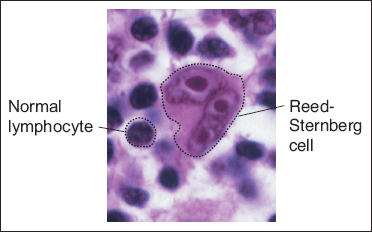Lymphoma Hodgkin, Childhood
Introduction:
This page has important information about Hodgkin lymphoma,* a cancer that starts in the immune system. This type of cancer is also called Hodgkin disease. Every year in the United States, more than 8,000 people learn they have this disease.
Cancer research has led to real progress against Hodgkin lymphoma. Most people diagnosed with Hodgkin lymphoma can now be cured, or their disease can be controlled for many years. Continuing research offers hope that, in the future, even more people with this disease will be treated successfully.
What Is Hodgkin Lymphoma?
Hodgkin Lymphoma Cells
Hodgkin lymphoma is a cancer that begins in cells of the immune system. The immune system fights infections and other diseases.
The lymphatic system is part of the immune system. The lymphatic system includes the following:
- Lymph vessels: The lymphatic system has a network of lymph vessels. Lymph vessels branch into all the tissues of the body.
- Lymph: The lymph vessels carry clear fluid called lymph. Lymph contains white blood cells, especially lymphocytes such as B cells and T cells.
- Lymph nodes: Lymph vessels are connected to small, round masses of tissue called lymph nodes. Groups of lymph nodes are found in the neck, underarms, chest, abdomen, and groin. Lymph nodes store white blood cells. They trap and remove bacteria or other harmful substances that may be in the lymph.
- Other parts of the lymphatic system: Other parts of the lymphatic system include the tonsils, thymus, and spleen. Lymphatic tissue is also found in other parts of the body including the stomach, skin, and small intestine.

This picture shows lymph nodes above and below the diaphragm. It also shows the lymph vessels, tonsils, thymus, and spleen.
Because lymphatic tissue is in many parts of the body, Hodgkin lymphoma can start almost anywhere. Usually, it's first found in a lymph node above the diaphragm, the thin muscle that separates the chest from the abdomen. But Hodgkin lymphoma also may be found in a group of lymph nodes. Sometimes it starts in other parts of the lymphatic system.
Hodgkin Lymphoma Cells
Hodgkin lymphoma begins when a lymphocyte (usually a B cell) becomes abnormal. The abnormal cell is called a Reed-Sternberg cell. (See photo below.)
The Reed-Sternberg cell divides to make copies of itself. The new cells divide again and again, making more and more abnormal cells. The abnormal cells don't die when they should. They don't protect the body from infections or other diseases. The buildup of extra cells often forms a mass of tissue called a growth or tumor.
See the Staging section for information about Hodgkin lymphoma that has spread.

Risk Factors
Doctors seldom know why one person develops Hodgkin lymphoma and another does not. But research shows that certain risk factors increase the chance that a person will develop this disease.
The risk factors for Hodgkin lymphoma include the following:
- Certain viruses: Having an infection with the Epstein-Barr virus (EBV) or the human immunodeficiency virus (HIV) may increase the risk of developing Hodgkin lymphoma. However, lymphoma is not contagious. You can't catch lymphoma from another person.
- Weakened immune system: The risk of developing Hodgkin lymphoma may be increased by having a weakened immune system (such as from an inherited condition or certain drugs used after an organ transplant).
- Age: Hodgkin lymphoma is most common among teens and adults aged 15 to 35 years and adults aged 55 years and older.
- Family history: Family members, especially brothers and sisters, of a person with Hodgkin lymphoma or other lymphomas may have an increased chance of developing this disease.
Having one or more risk factors does not mean that a person will develop Hodgkin lymphoma. Most people who have risk factors never develop cancer.
Symptoms
Hodgkin lymphoma can cause many symptoms:
- Swollen lymph nodes (that do not hurt) in the neck, underarms, or groin
- Becoming more sensitive to the effects of alcohol or having painful lymph nodes after drinking alcohol
- Weight loss for no known reason
- Fever that does not go away
- Soaking night sweats
- Itchy skin
- Coughing, trouble breathing, or chest pain
- Weakness and tiredness that don't go away
Most often, these symptoms are not due to cancer. Infections or other health problems may also cause these symptoms. Anyone with symptoms that last more than 2 weeks should see a doctor so that problems can be diagnosed and treated.





































